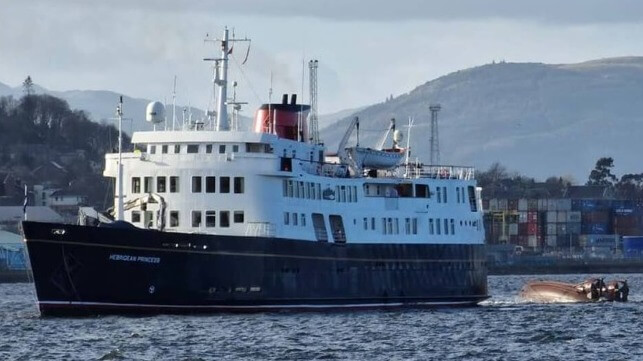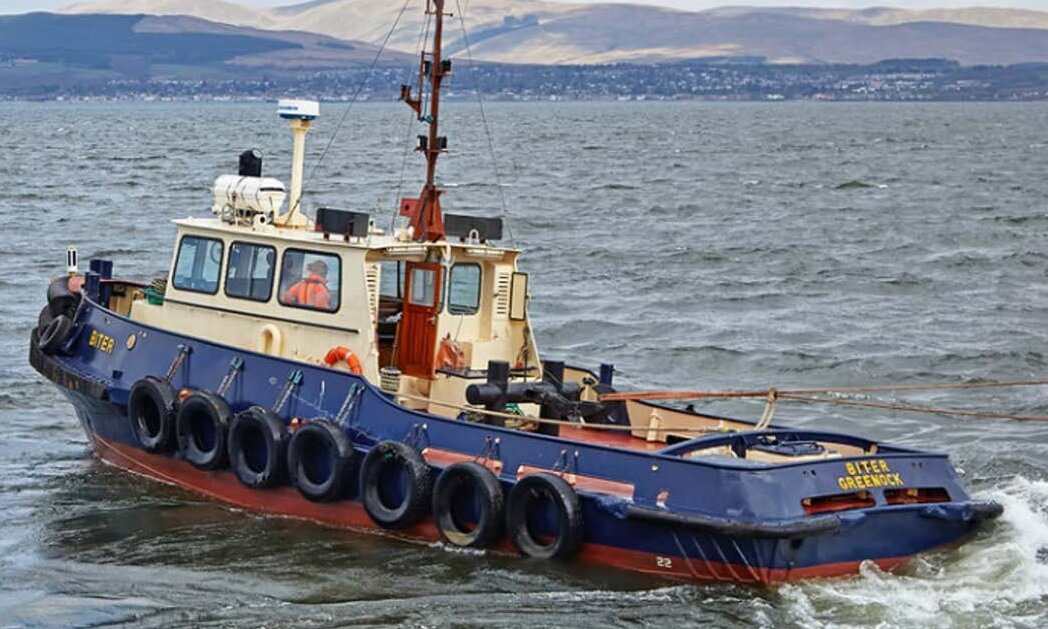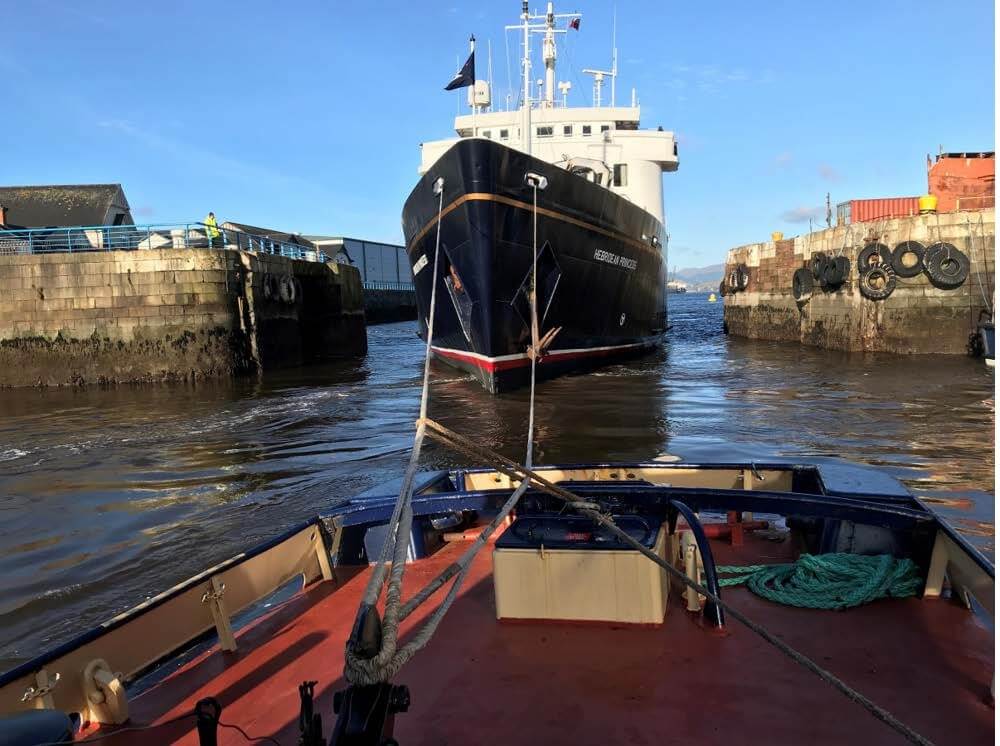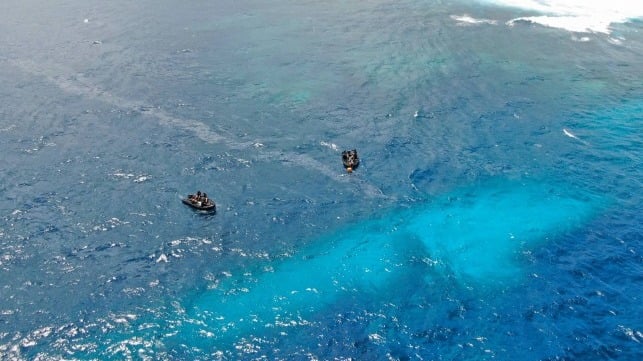Faulty Rigging, High Speed Caused Fatal Tug Girting

The UK's Marine Accident Investigation Branch has released its report on the loss of the tug Biter, which was girted and capsized while carrying out a ship assist maneuver at Greenock, Scotland last year.
On the morning of February 24, 2023, the passenger vessel Hebridean Princess got under way from the James Watt Dock at Greenock for a day of sea trials. At about 1420 that afternoon, the Princess took aboard a harbor pilot and prepared to return to her berth. She would need to enter the narrow harbor stern first in order to moor in the planned arrangement.
Hebridean Princess had two tugs available to assist, the Bruiser and the Biter. The Princess lacked centerline fairleads fore and aft, so the tugs made up using a twin-rope bridle with two eyes made fast on port and starboard cleats on the ship.
At about 1515, Biter approached the starboard quarter of Princess and a heaving line was passed over, then the twin towline made fast on the passenger vessel's stern. Biter's crew rigged the tow with a running gog line, a traditional fairlead system with the same function as a towing pin system. The adjustable gog line runs from a centerline cleat at the stern, then loops around the tow line; like tow pins, it prevents the tow line from being pulled across the tug's beam, thereby reducing the risk of girting. Some twin-screw tug operators prefer a gog line since it can be slackened to allow the tow line to come amidships when needed, bringing the tow line closer to the tug's pivot point and thereby making the most of the vessel's limited maneuverability.

Biter's towing arrangements: a twin-leg bridle towline, secured aft by a fiber-rope HMPE gog line looped around the towline and secured with wraps on the samson post (MAIB)

Biter's gog line and twin-leg bridle towing assembly on the morning of the casualty, outbound with Hebridean Princess in tow (MAIB)
At about 1526, the pilot instructed Biter to apply minimum thrust to pull Princess dead astern. He was new, and believed Biter would maneuver as an ASD tug, but this was not correct. The maneuver would require Biter to orient herself stern-to-stern, pointing opposite to Princess' direction of travel as the passenger vessel passed into the harbor.
At 1526:40, Biter's master - a 65-year-old tow captain with 45 years of experience - executed the turn to starboard to pull away from Princess and flip around. 18 seconds later, the starboard leg of the tow bridle came taught, and the tug's turn stopped. The Biter was angled about 45 degrees to starboard away from the Princess' direction of travel, and as Princess continued ahead at more than four knots, the bridle immediately pulled Biter sideways. The small tug heeled to port, water flooded over her bulwarks, and at 1528:08 - less than 30 seconds after beginning her turn - Biter capsized. Her propellers were still spinning, and her rudders were still turned to starboard. The emergency tow hook release had not been activated.
An emergency response was mounted, but there were no signs of life, and Biter sank later that day. Divers found the bodies of the master and the deckhand inside the cabin; the tug was raised the following month, and was declared a total loss.
Investigators found no mechanical problems aboard Biter, but did find several serious operational issues. First, they found that the master-pilot exchange process was lacking, and it left no opportunity for the tug masters to give input on plans for maneuvering and speed. Second, the speed of the Princess at the time of the maneuver - 4.6 knots - was much higher than recommended for operations at Greenock, and exerted excessive force on Biter's towline, a serious danger for a stern-to-stern towing maneuver.
Conventional ship assist tugs typically flip around stern-first to provide traction astern when needed, and while the maneuver is safe if properly executed, it is a known girting hazard if the ship is moving too fast. According to the practical guide Tug Use in Port, it can be done at higher speed with a gob line - but "the gob rope system should be strong enough and fully reliable, otherwise such a maneuver becomes really dangerous for the tug."
The gob line on Biter was made of HMPE, not wire rope or chain, and about nine feet of the line had melted and fused where it had been wrapped around the samson post for securing. There were no locking turns on the post. The melt suggested that the force on the towline had pulled all 4-5 wraps of the gob line around the samson post through a distance of about nine feet, allowing the tow line to slip dangerously forward towards the tow hook. Now exerting force from amidships, unrestrained by the gob line, the tow line girted the tug.
"While it was not possible to determine exactly why Biter’s gob rope failed, the practice of securing Biter’s gob rope to a samson post, when combined with the low friction coefficient of the HMPE rope, might therefore have allowed the gob rope to render more easily than an alternative securing arrangement [like figure-eights]," MAIB concluded.
Even if the gob line had not slipped, the deck securing point was so close to the tow hook that the system's effectiveness was reduced anyways, MAIB found. Placing the fairlead all the way aft, as close as possible to the transom, would have maximized safety.
Divers also found that the watertight hatch to the accommodations area was open, even though marked to "keep closed at sea" per company policy. Open hatches are a common factor in tug sinkings, and greatly accelerate downflooding.
After One Month, New Zealand's Navy Prepares to Defuel Sunken Ship

The New Zealand Defence Force is closing in on an operation to remove the fuel from the lost survey ship Manawanui, which ran aground and sank off Samoa in October. The service has revised its defueling plan and secured approval from Samoan authorities to proceed, and is in final talks with a commercial salvor.
"Once the fuel removal contract has been finalized, the salvor will be mobilizing equipment and personnel to Samoa to remove the fuel and other pollutants from the ship," Commodore Andrew Brown said.
The Royal New Zealand Navy has rotated in a new group of personnel on the ground in Samoa to monitor the wreck and assist with the salvage operation. The vessel's main fuel tanks remain intact, and the service is keeping up daily drone surveillance of the site. "The New Zealand Defence Force will maintain an appropriate presence in Samoa until all aspects of the recovery operation have been completed," Commodore Brown said.
After NZDF conducted a site visit on November 5 with the salvor and Samoan authorities, plans for extracting fuel from Manawanui's tanks were adjusted and finalized.
HMNZS Manawanui went aground near a reef on the southern coast of Upolu, Samoa on October 5. The commanding officer ordered the 75 crewmembers aboard the vessel to abandon ship, and all made it safely to shore, despite rough surface conditions. Several of the survivors were injured while crossing a reef to reach safety, but all survived. The Manawanui did not fare as well: the vessel listed, caught fire and sank the following morning.
The NZDF convened a formal Court of Inquiry on the sinking, and on Wednesday, the service announced that it had received the court's interim factfinding report. In a statement, Chief of Navy Rear Admiral Garin Golding said the court had made good progress and was on track with interviews and evidence gathering. The interim report will be analyzed by a government legal team, and some of its details will be released to the public later this month. The final report - which will include the court's conclusions - is expected by the end of February.
"I am aware of the desire to have answers, and while it is important the Court works expeditiously, it is also vital to respect the process and carefully step our way through it," Golding said.
No comments:
Post a Comment